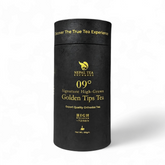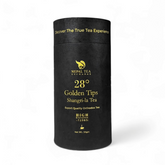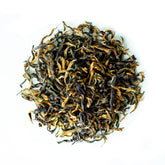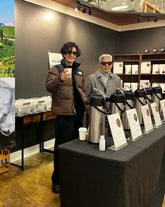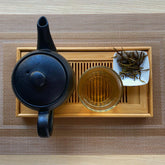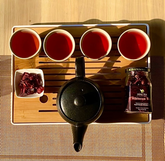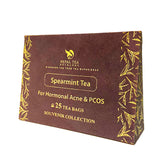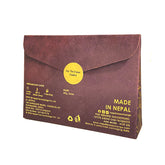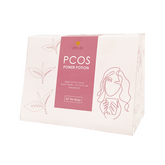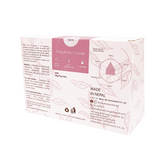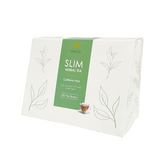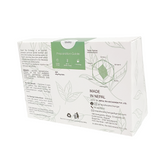Oolong Tea: A Distinctive Flavor and Aroma

Oolong Tea, sourced from the Mid-eastern Himalayas of Nepal is bulky leaves carefully hand rolled to create an utterly delicious tea with a balanced oxidation level range of 50-70%. If you're a tea lover or someone who enjoys exploring different types of beverages, you might have heard of Oolong tea. In this article, we'll take a closer look at what Oolong tea is, how it's produced, its flavor profile, and the potential health benefits it offers.
Oolong Tea: A Combination of Black Tea and Green Tea
Oolong tea is a type of "traditional tea" that falls somewhere between black tea and green tea in terms of oxidation levels. It is partially oxidized, meaning that the leaves are allowed to undergo a controlled process of oxidation, which results in a distinctive flavor and aroma.
Oxidation is a process that occurs when the enzymes in tea leaves react with oxygen in the air. This process is responsible for the changes in color and flavor that occur during tea production. Green tea is unoxidized, while black tea is fully oxidized. Oolong tea is partially oxidized, which gives it a unique flavor profile that is different from both green and black tea.
The Flavor Profile of Oolong Tea
Oolong tea has a rich and complex flavor profile that is often described as being somewhere between green tea and black tea. The taste can vary widely depending on the specific variety of oolong tea, but it generally has a floral and fruity flavor with a slightly sweet and nutty finish. The color of the tea can range from pale yellow to dark amber, depending on the degree of oxidation.

The flavor of oolong tea is influenced by several factors, including the variety of the tea plant, the growing conditions, and the production process. The level of oxidation also plays a significant role in determining the flavor profile of oolong tea. A lightly oxidized oolong tea will have a greener, more floral taste, while a more heavily oxidized oolong tea will have a darker, more robust flavor.
|
Check out our Exclusive Nepal Oolong Tea. Click Here
|
How Oolong Tea is Produced

The production of oolong tea involves several steps, including withering, rolling, and drying. The withering process involves allowing the tea leaves to wilt in the sun for a period of time, which helps to reduce the moisture content and increase the concentration of flavor compounds. The rolling process involves carefully rolling the leaves to break down the cell walls, which helps to release the essential oils and other flavor compounds. Finally, the leaves are dried to stop the oxidation process and preserve the flavor.
The specific production process used for oolong tea can vary depending on the region and the type of tea being produced. Some oolong teas are lightly oxidized and have a greener flavor, while others are more heavily oxidized and have a darker, more robust flavor.
Health Benefits of Oolong Tea
Oolong tea is often prized for its health benefits. It is believed to contain a wide range of antioxidants and other compounds that can help to improve overall health and wellness. Some of the potential benefits of drinking oolong tea include:
Boosting Metabolism
Oolong tea contains caffeine, which is a natural stimulant that can help to boost metabolism and increase energy levels. Some studies have shown that drinking oolong tea may help to increase fat burning and promote weight loss.
Reducing the Risk of Heart Disease and Stroke
Several studies have suggested that drinking oolong tea may help to reduce the risk of heart disease and stroke. Oolong tea contains antioxidants called catechins, which are believed to help improve cardiovascular health by reducing inflammation and improving blood flow.
Boosts cognitive function
Oolong tea contains caffeine and L-theanine, which can help to improve cognitive function and reduce mental fatigue. It may also help to improve memory and concentration.
Reduces the risk of cancer
Some studies have found that oolong tea may help to reduce the risk of certain types of cancer, including breast cancer, ovarian cancer, and prostate cancer. This may be due to its high levels of antioxidants and other beneficial compounds.
Oolong Tea In Nepali Tea Industry
Did you know that Nepal, a country known for its majestic Himalayan mountains, has become a major producer of high-quality teas, including black and green teas? In recent years, some tea producers in Nepal have also started experimenting with oolong tea production, using techniques and tea plants from China. These Nepali oolong teas may have unique flavor profiles that reflect the country's terroir and growing conditions.
Where to Find Finest Quality Oolong Tea?
Nepali Oolong tea can be directly purchased from Nepal Tea Exchange, an Exporter , Promoter, Purveyor and Global Marketer of Export grade finest quality Orthodox teas produced in the Himalayas of Nepal.
FAQs
Q: What types of teas has the Nepali tea industry focused on producing in recent years?
A: In recent years, the Nepali tea industry has focused on producing black and green teas, which have gained popularity in the international market.
Q: What is Nepali Oolong tea?
A: Nepali oolong tea is a type of oolong tea produced in Nepal using techniques and tea plants from China. The unique terroir and growing conditions of Nepal may give Nepali oolong teas a distinct taste and aroma.
Q: What flavors and aromas can be expected from Nepali Oolong tea?
A: Nepali oolong teas may have flavor notes of honey, floral, and fruity, with a subtle smokiness. The aroma of Nepali oolong teas may also vary, depending on the degree of oxidation, with a floral and fruity aroma in light oolong teas and a smoky aroma in dark oolong teas.
Q: Where can I find Nepali Oolong tea?
A: Nepali oolong tea is not widely available in the international market, but it may be found online or in specialty tea shops that carry a wide variety of teas. Some Nepali tea producers also sell their products directly to consumers through their websites.
Q: Do Oolong tea have caffeine?
A: The caffeine content in oolong tea can vary depending on the specific type and how it is brewed. On average, an 8-ounce cup of oolong tea contains around 30-50 milligrams of caffeine, which is less than a cup of coffee but more than a cup of green tea. However, caffeine levels in oolong tea can range from as little as 12 milligrams to as much as 55 milligrams per cup.


